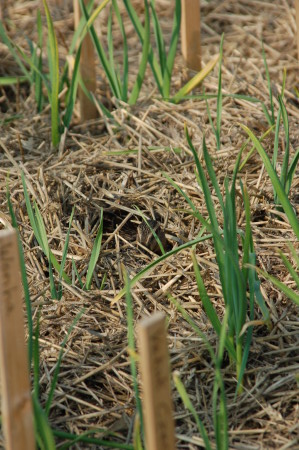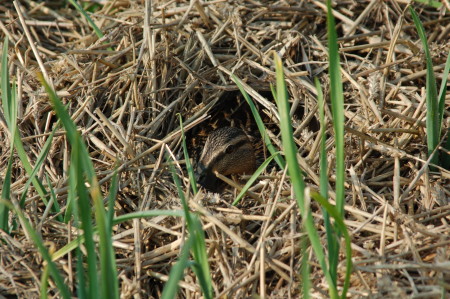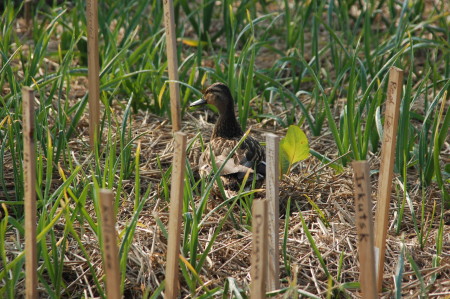If you came here expecting a recipe, you’ve come to the wrong place.

Do you see it there in the middle?

Here’s a closer look…

Here’s the whole thing.
It the past I’ve had hedgehogs, birds nests, wasps even ants, but I’ve never before had a duck’s nest in my garden. Snuggled comfortably between the Red Toch and the Russian Softneck, with it’s home in the straw. Three eggs are waiting with the next generation inside.
I discovered her a few days ago, after being in the garden for a few hours. Completely unaware of her, I got a little too close causing her to fly away in a panic. I don’t know who was more frightened, her or me as a duck suddenly took off almost vertically from my garden about a meter from where I was standing.
I have not seen any slugs or snails this year! It could just be luck, but I think I’ve already encountered the first benefit of having a resident garden duck. I’ve seen other garden bloggers joke about a slug or snail problem really only being a matter of a duck deficiency. Well I can assure you, I have no such problem!
According to what I’ve read on the Internet, duck eggs take about a month to hatch, so for the next several weeks she and I will both have to share the garden space. Fortunately she picked a part of the garden I don’t need to go into often these days.


Wow, I sure could use one of those in my garden. Snails are going crazy this year. I can’t cope with them. It will be interesting to see the babys when they hatch.
How lucky you are to have such a fine duck in your garden. I know it can be perfectly safe with you, not ending in a recipe with garlic 🙂
I’m curious to learn if it at some point will start to share you vegetables, and what is to the taste of a duck. In few years I expect my own garden to become duck deficient, as killeslugs have come to the neighborhood.
Such a comely little animal! I never gave much thought to duck diet. I’ll be interested to know if it’s vegetarian at all as well. What the heck is a killeslug?
Hi Jo,
I think Søren dropped an ‘r’, it should be killer.
The common grey slug is what most places in the US have by now, but in many (maybe most) areas this is an invasive species. You may be familiar with the Santa Cruz banana slug, an example of a native species.
Many places in Europe still have native slugs and snails that are in the process of being displaced by these grey colored (killer) invasive species.
Søren has a very special leopard slug in his garden:
http://toads.wordpress.com/2007/10/04/a-leopard-in-the-garden/
and we both have the burgundy snail:
http://toads.wordpress.com/2008/05/08/the-burgundy-snail/
They grey variety is called killer in part because it’s very destructive compared with most native species, but also because it’s aggressive and displaces native varieties. For example my garden is usually full of burgundy snails, and my plants often have lots of tiny holes in them, but compared to the killer varieties the damage is very minor.
There’s another benefit to having the burgundy snail in your garden. You can eat them!
http://toads.wordpress.com/2008/05/09/my-uncles-escargots/
I don’t yet have the killer varieties, but they will come someday for sure.
What a wonderfull picture to watch.
Nice, Patrick. Cute. Snails with garlic are popular in France….where is the nest again??
A kangaroo keeps nibbling my friend’s quinces….at least a duck does something useful!
I missed this story last year. LOL – made me really laugh – what a duck. Nest in the garden – I would never expect that.